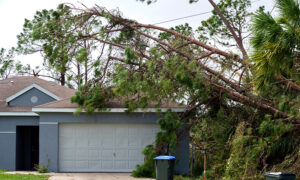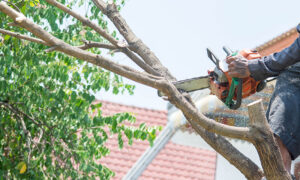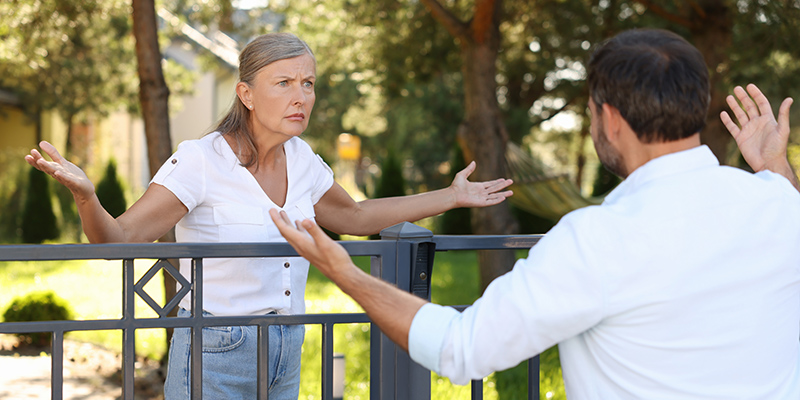What should homeowners do if a neighbors tree is overhanging, encroaching, or has caused property damage? Let’s explore how neighborhood trees can cause conflict and what to do about them.
Neighbors Tree Disputes in HOAs
Many homeowners plant trees on their property to beautify their yard’s landscaping. Some even plant trees for privacy from neighbors. However, as people do, trees do not follow the governing documents or encroachment laws. They grow tall and wide and do not obey property lines. This is why conflict regarding trees is one of the most common sources of disputes in HOA communities.
Property Encroachment
Often, HOA neighbor’s tree disputes involve property encroachment. It’s not uncommon to find overhanging tree branches in the HOA community. This can be a nuisance for neighbors whose view from the front yard might be blocked. Tree overhangs can also pose a security risk, as trespassers can use the overhangs to climb over fences. Overhanging branches can also cause a mess as tree leaves and fruits may fall onto the neighbor’s property.
Encroachment issues may also involve tree roots or the way the tree grows. Let’s say the tree’s trunk or roots grow into the neighbor’s yard or property. Who owns the tree? Moreover, who has the right to eat its fruits and is responsible for tree trimming and maintenance? These can be tricky to navigate as it may vary between states and communities.
Property Damage
 A neighbors tree can also cause damage and it can be hard to know who to hold responsible. There are many instances wherein these accidents are deemed as “Acts of God.”
A neighbors tree can also cause damage and it can be hard to know who to hold responsible. There are many instances wherein these accidents are deemed as “Acts of God.”
In these cases, the property owner is responsible for repairs and maintenance, even if the tree isn’t theirs. The same applies to homeowners associations. If the HOA’s sidewalks or common elements are damaged by homeowner trees, the HOA is often responsible if it is an act of God.
However, there are times when the tree owner is responsible for property damage. This often happens when the tree owners can’t properly care for the tree to prevent it from causing harm. It also applies when the tree owner knows that their tree poses a threat yet does nothing to remove or prune the tree.
The First Question to Ask: Who Owns the Tree?
Before identifying who is liable for various tree-related issues, it’s important to establish who owns the tree. This can shed much light on who may be held responsible for damages, encroachment, or upkeep. It also determines who can prune or cut the tree down.
As such, reviewing the community’s plat or map to determine property lines is essential. If a tree resides on the HOA property, the tree will likely belong to the HOA. Meanwhile, if a tree resides on a resident’s property, the resident is responsible for the tree. This usually applies regardless of who planted the tree in the first place.
Apart from this, the state’s tree law often determines ownership. For instance, California determines ownership based on where the tree trunk stands. If the tree trunk stands wholly on a neighbor’s property, then the neighbor owns the tree.
However, if the tree trunk stands partly on the land of two or more properties, it’s usually deemed a boundary tree. In many cases, all the property owners jointly own the tree. Hence, they are all responsible for caring for the tree. Moreover, if the tree is healthy, no one property owner can remove the tree without the permission of the other owners.
It’s also important to note that, depending on state law, tree roots typically do not determine ownership. Even if the tree’s roots grow well into a resident’s yard, that resident still does not own the tree. Ownership determines where the tree trunk stands, not where the roots grow.
Finally, it’s also crucial to review the governing documents. Special provisions may outline who is responsible for tree maintenance, trimming, and property damage. The HOA may also have a tree policy that the board and the other residents must follow.
How to Deal With Neighbors Tree Disputes
What can homeowners and HOAs do when it comes to tree disputes? Let’s address the most common questions and concerns homeowners have.
 Can I Trim a Neighbor’s Trees Overhanging My Property?
Can I Trim a Neighbor’s Trees Overhanging My Property?
In many states, homeowners can trim limbs and branches that exceed property lines. However, homeowners have to trim only up to the boundary. They cannot go onto their neighbor’s property to trim the tree.
Moreover, it’s never a good idea to destroy the neighbor’s tree. This is because harming the tree will likely lead to liability and monetary penalties.
Can I Eat the Fruit From the Neighbor’s Tree if It Overhangs My Yard?
It depends on the state. Fruits belong to the tree owner, so it’s best not to pick fruits if the tree does not belong to you. However, state laws and courts are divided on whether or not homeowners can eat their neighbor’s fallen fruit. It’s best to check local laws and ordinances before eating the fruit. Otherwise, you may incur penalties.
Who Is Responsible if the Neighbor’s Tree Damaged My Property?
“A neighbor’s tree damaged my fence, what do I do? What are my options if the neighbor’s tree damaged my house?” In these cases, it depends on what caused the damage. The court will likely turn to the reasonable care standard if the tree fell due to a storm or natural disaster.
This means that if the neighbor took reasonable care of the tree and maintained it properly, the neighbor is likely not responsible for the damage. It may be deemed an “act of God.” In this case, the property owner is responsible for repairing the fence or the home. However, if the neighbor did not properly maintain the tree or knew its branches were a threat, they may be liable for the damages.
Apart from natural disasters, growing tree branches and roots can also cause damage. In most cases, the homeowner cannot sue the neighbor for the roots or branches. Hence, trimming the tree’s branches and roots is the safest option to avoid potential damage.
On the other hand, some states do allow homeowners to sue if certain conditions are met. For example, some states allow lawsuits if the invading branches or roots cause serious harm to the homeowner’s property. They may also be able to sue if the encroaching tree is planted and not “wild.” Regardless, it’s best to check state law to verify what you can do if the neighbor’s tree branches or roots cause property damage.
What Can I Do if the Neighbor’s Tree Looks Like It Will Fall on My House?
Homeowners are responsible for making reasonable inspections and taking care of trees to ensure safety. If the neighbor does not remove or cut the tree and it causes damage, the neighbor may be liable for it. Make sure to speak to the neighbor about the potential threat. If you do, the law may be able to protect you.
Apart from this, you can call your municipality, as most city ordinances forbid homeowners from maintaining dangerous conditions, including dangerous trees, on their property. The municipality may remove the tree or order the neighbor to remove the tree.
Dangerous trees may also pose a threat to utility companies. If the tree threatens the utility company’s equipment or is a fire hazard, the utility company may help you remove the tree.
Finally, you can file a nuisance claim as the tree may interfere with the use and enjoyment of your property. If the court thinks the tree is a nuisance, they may order the neighbor to remove or prune it. You must file a lawsuit in regular court, but be ready to present evidence that the tree is hazardous.
Can I Be Compensated if a Neighbor Killed My Tree?
Yes. Those who hurt, remove, or cut down trees without the owner’s permission are often liable to the owner. The tree owner may ask for compensation or file a lawsuit to enforce that right.
Do I Have a Good Nuisance Claim if the Neighbor’s Tree Leaves Blow Into My Yard?
No. Leaves are often considered natural products. Hence, the homeowner cannot file a legal claim against their neighbor even if they damage the property by clogging pipes or gutters.
Do I Have to Trim My Tree if the Neighbors Complain About Its Height?
 It’s best to talk to your neighbors to understand how much trimming would be enough. If they’re not asking for too much, and trimming doesn’t affect the tree’s health or aesthetics, it’s best to consider trimming it.
It’s best to talk to your neighbors to understand how much trimming would be enough. If they’re not asking for too much, and trimming doesn’t affect the tree’s health or aesthetics, it’s best to consider trimming it.
This can help you avoid conflict with your neighbor and maintain a peaceful community. They may even agree to cover or split the cost of tree trimming. However, hire a professional neighborhood tree service to do the job. A neighbor tree service can ensure the tree is trimmed without affecting its health or visual appeal.
On the other hand, if you do not want to trim the tree, it’s important to review local tree ordinances. Let’s say the tree is hazardous to your neighbor as its branches dangerously overhang their property. You may violate a local ordinance by not trimming the tree in this case.
Apart from this, some laws may impose height limits, view ordinances, or property line limits. Make sure your refusal does not violate any local laws. Otherwise, you may find yourself in court over the tree dispute. It’s also important to check the HOA’s governing documents. The community might have restrictions regarding tree heights or rules about tree trimming that you need to follow.
Navigating Tree Disputes
Trees are often a point of tension within private communities. That’s why communities need to know how to deal with disputes involving a neighbors tree. They must understand how ownership works, what they’re responsible for, and what they cannot do.
Are you in need of reliable HOA management software? Condo Manager offers the best tools for self-managed communities and HOA management companies. Call us today at (800) 626-1267 or reach out to us online to book a demo!
RELATED ARTICLES:
- 13 Common HOA Violations To Avoid
- How To Remove An HOA Board Member Or Officer?
- Should You Or Should You Not Have An HOA Pool Lifeguard?



